BYD have done what some (specifically Boris Johnson) thought would not be possible and built electric double deckers. These BYD K8SRs with Metroline have fleet numbers BYD1471-1474 (currently).
TfL already have BYD electric single decker buses operating on the 507 and the 521.
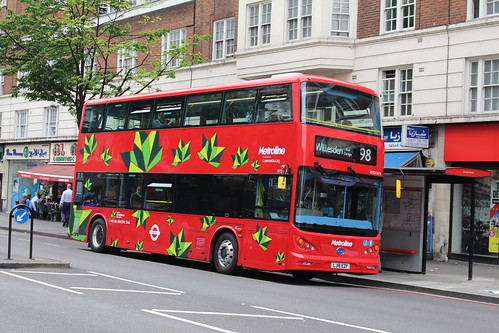
Metroline BYD1474 on Route 98, Edgware Road (© Aubrey)
These buses have entered service on the busy 98 route between Willesden and Holborn (temporarily Russell Square), and it's night version, the N98, bringing electric buses up to Stanmore. Initially rumoured to be for the 16, as it gained LTs, the 98 gained these BYD electric double deckers. Initially paraded as part of the centre-right government trade advertisement (which explains the extreme placing of Metroline logos on some buses), they later went under testing with fully laden loads on the 98 doing route simulations as shown:

Metroline BYD1472 on Route 98 Testing, Oxford Circus (© Aubrey)
Two months after initial unveiling, on 6th May, the bus entered service after large scale preparation for London service on the busy Route 98.

Metroline BYD1474 on Route 98, Edgware Road (© Aubrey)
These buses have entered service on the busy 98 route between Willesden and Holborn (temporarily Russell Square), and it's night version, the N98, bringing electric buses up to Stanmore. Initially rumoured to be for the 16, as it gained LTs, the 98 gained these BYD electric double deckers. Initially paraded as part of the centre-right government trade advertisement (which explains the extreme placing of Metroline logos on some buses), they later went under testing with fully laden loads on the 98 doing route simulations as shown:

Metroline BYD1472 on Route 98 Testing, Oxford Circus (© Aubrey)
Two months after initial unveiling, on 6th May, the bus entered service after large scale preparation for London service on the busy Route 98.
Metroline BYD1472 on Route 98, Russell Square (© Anthony)
These buses have the predictable high torque (meaning people could be thrown back), common with electric and hybrid buses. There is a notable step up to the rear (bottom deck) seats, which is likely to catch some people out. The seats that they do sit on are fairly hard.

(© Anthony)
This large step is likely due to the proximity of the batteries and the rear axle.
(© Anthony)
The iBus is located at the front of the bus, practically inside the driver cab. This affects visibility of the iBus from the lower deck, as seen here:
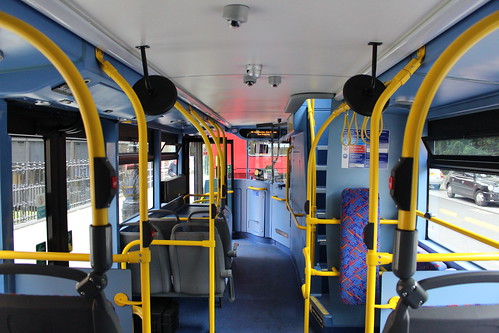
Lower Deck Interior of Metroline BYD1472 (© Aubrey)
The lower deck iBus is obscured by the driver assault screen. The general, typical layout of a lower deck is shown. Other than the reduced length of the rear part of the bus due to the batteries, the bus has a layout like any other lower deck.

Lower Deck Interior of Metroline BYD1472 (© Aubrey)
The lower deck iBus is obscured by the driver assault screen. The general, typical layout of a lower deck is shown. Other than the reduced length of the rear part of the bus due to the batteries, the bus has a layout like any other lower deck.
The BYD also has an interesting sounded bell. Some say it's excessively annoying, and not well thought through. But it does the job as a bell. It's not as bad as the rear door alarm. On initial running of BYD1472, there was no rear door alarm. However, when done on the N98 later on in June, the bus had gained a rear door alarm which sounded like it was retrofitted from a Wright bus, but faster.
This bus also has three "bus stopping" signs, contrary to the usual two (or none due to iBus). The one above is located on the upper deck next to the iBus.

⇐ This one is located at the rear doors on the left (towards the rear of the bus)
This one is located at the front ⇒
doors.

(© Aubrey)
Yup, this does mean that the bus has an official capacity of 79 people with one wheelchair (81 without). Double deckers allocated for TfL work have a capacity of about 86 people. This could prove to be a problem, notably on the fairly busy 98. Even with cram room, there are less people who would be able to fit inside the lower deck of the bus.
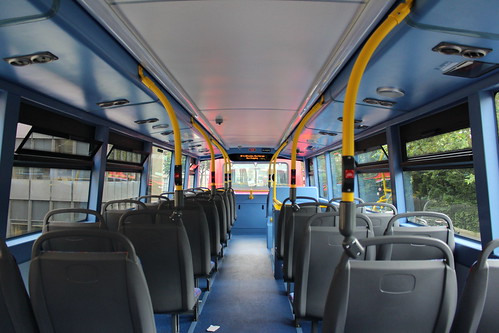
Upper Deck Interior of Metroline BYD1472 (© Aubrey)
The upper deck has opening windows and, weirdly, non-working air vents above most seats. Certainly on a tested journey, this feature was not working. Otherwise, it just seems like a normal upper deck with slightly hard seats. However, there are reports that say that this bus is air conditioned. This would explain the vents, similar to ones in Hong Kong buses.
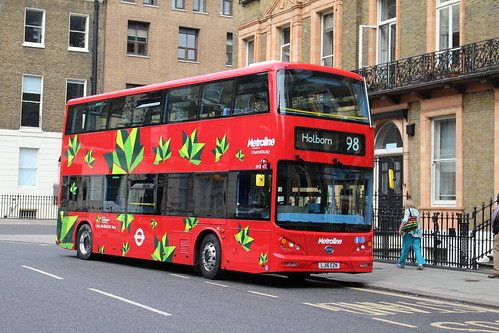
Metroline BYD1472 on Route 98, Russell Square (© Aubrey)
A ride on the 98 and N98, on the same bus, turned out to be smoother than expected, with good braking and fast acceleration. Some may say it looks, feels and shouts cheap. However, this itself is a technological achievement, and one that Alexander-Dennis might as well put an Enviro 400 body on. To prove the concept that double deck electric buses can be done, these buses definitely do the job. In day to day life, that is yet to be known. But as the Red Arrow BYDs have soldiered on with some modifications, these buses will have a good few years in them.
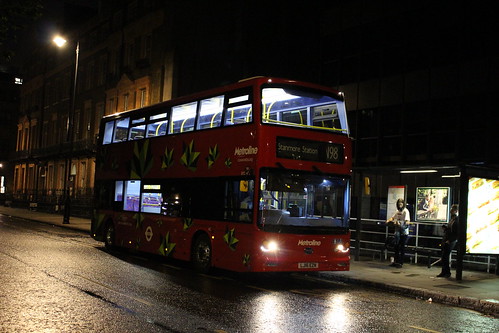
Metroline BYD1472 on Route N98, Russell Square (© Aubrey)
That is, if too many runs on the N98 doesn't run down this bus. And if BYD1471 wouldn't crash into Willesden Garage. Notably, the blind lights are not on in the shot of the N98. Decent execution of what could easily be conceived as a dream. Yes, BYD does build Boris's dream. That isn't a Borismaster.

⇐ This one is located at the rear doors on the left (towards the rear of the bus)
This one is located at the front ⇒
doors.
These buses have iron phosphate (Fe3(PO4)2) batteries which give out 345 kWh of power and can go 190 miles. Back at Willesden Garage, the buses just need about four hours to recharge. BYD are well rehearsed in batteries, with similar batteries being found across their range of vehicles, including single deck buses and cars. However, to move a larger mass of bus means more power needs to be provided. To sustain range, large battery packs at the rear are provided. This however does mean that the capacity of the bus is reduced.
The capacity of the bus is as shown:
The capacity of the bus is as shown:

(© Aubrey)
Yup, this does mean that the bus has an official capacity of 79 people with one wheelchair (81 without). Double deckers allocated for TfL work have a capacity of about 86 people. This could prove to be a problem, notably on the fairly busy 98. Even with cram room, there are less people who would be able to fit inside the lower deck of the bus.

Upper Deck Interior of Metroline BYD1472 (© Aubrey)
The upper deck has opening windows and, weirdly, non-working air vents above most seats. Certainly on a tested journey, this feature was not working. Otherwise, it just seems like a normal upper deck with slightly hard seats. However, there are reports that say that this bus is air conditioned. This would explain the vents, similar to ones in Hong Kong buses.

Metroline BYD1472 on Route 98, Russell Square (© Aubrey)
A ride on the 98 and N98, on the same bus, turned out to be smoother than expected, with good braking and fast acceleration. Some may say it looks, feels and shouts cheap. However, this itself is a technological achievement, and one that Alexander-Dennis might as well put an Enviro 400 body on. To prove the concept that double deck electric buses can be done, these buses definitely do the job. In day to day life, that is yet to be known. But as the Red Arrow BYDs have soldiered on with some modifications, these buses will have a good few years in them.

Metroline BYD1472 on Route N98, Russell Square (© Aubrey)
That is, if too many runs on the N98 doesn't run down this bus. And if BYD1471 wouldn't crash into Willesden Garage. Notably, the blind lights are not on in the shot of the N98. Decent execution of what could easily be conceived as a dream. Yes, BYD does build Boris's dream. That isn't a Borismaster.





No comments:
Post a Comment
Note: only a member of this blog may post a comment.